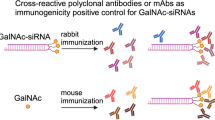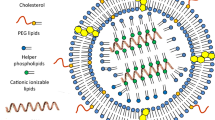Abstract
The lipopeptide, R4Pam2Cys, associates electrostatically with soluble protein antigens and significantly enhances their ability to induce protective humoral and cell-mediated responses. We demonstrate that antibody titers elicited by the antigen ovalbumin (OVA) associated with R4Pam2Cys are higher than those elicited by OVA in the presence of alum and comparable to those elicited by OVA formulated with complete Freund’s adjuvant (CFA). The hierarchy of anti-OVA antibody avidities was CFA > R4Pam2Cys = alum. Each of the three adjuvants facilitated IgG class-switching with significantly more IgG1 elicited by OVA when formulated with R4Pam2Cys. The effects of substituting naturally occurring l-stereoisomers of the cationic residues within R4Pam2Cys with d-stereoisomers revealed that substitution did not affect the ability of R4Pam2Cys to stimulate dendritic cell maturation or its ability to elicit antibody production when used as an adjuvant. Minor detrimental effects were, however, observed in the ensuing CD8+ T cell responses suggesting that the use of d-amino acids affects antigen processing and presentation pathways involved in generation of cell-mediated immunity at least when facilitated through TLR2. Both d- and l-forms were found to be resistant to digestion by trypsin, indicating resistance of the branched structure to protease activity.








Similar content being viewed by others
References
Bargieri DY, Rosa DS, Braga CJM et al (2008) New malaria vaccine candidates based on the Plasmodium vivax merozoite surface protein-1 and the TLR-5 agonist Salmonella typhimurium FliC flagellin. Vaccine 26:6132–6142. doi:10.1016/j.vaccine.2008.08.070
Boes M (2000) Role of natural and immune IgM antibodies in immune responses. Mol Immunol 37:1141–1149
Bossola M, Pacelli F, Costelli P et al (2008) Proteasome activities in the rectus abdominis muscle of young and older individuals. Biogerontology 9:261–268. doi:10.1007/s10522-008-9135-9
Bourel L, Carion O, Gras-Masse H, Melnyk O (2000) The deprotection of Lys(Mtt) revisited. J Pept Sci 6:264–270. doi:10.1002/1099-1387(200006)6:6<264:AID-PSC248>3.3.CO;2-1
Bracci L, Lozzi L, Pini A et al (2002) A branched peptide mimotope of the nicotinic receptor binding site is a potent synthetic antidote against the snake neurotoxin alpha-bungarotoxin. Biochemistry 41:10194–10199
Bycroft BW, Chan WC, Chhabra SR, Hone ND (1993) A novel lysine-protecting procedure for continuous flow solid phase synthesis of branched peptides. J Chem Soc, Chem Commun. doi:10.1039/C39930000778
Chen X, Oppenheim JJ, Howard OMZ (2005) BALB/c mice have more CD4+ CD25+ T regulatory cells and show greater susceptibility to suppression of their CD4+ CD25− responder T cells than C57BL/6 mice. J Leukoc Biol 78:114–121. doi:10.1189/jlb.0604341
Chua BY, Eriksson EM, Poole DP et al (2008) Dendritic cell acquisition of epitope cargo mediated by simple cationic peptide structures. Peptides 29:881–890. doi:10.1016/j.peptides.2008.01.025
Chua BY, Kobaisi Al M, Zeng W et al (2011a) Chitosan microparticles and nanoparticles as biocompatible delivery vehicles for peptide and protein-based immunocontraceptive vaccines. Mol Pharm. doi:10.1021/mp200264m
Chua BY, Pejoski D, Turner SJ et al (2011b) Soluble proteins induce strong CD8+ T cell and antibody responses through electrostatic association with simple cationic or anionic lipopeptides that target TLR2. J Immunol 187:1692–1701. doi:10.4049/jimmunol.1100486
Chua BY, Kobiasi MA, Zeng W et al (2012) Chitosan-based particles as biocompatible delivery vehicles for peptide and protein-based vaccines. Procedia Vaccinol 6:74–79. doi:10.1016/j.provac.2012.04.010
Chua BY, Olson MR, Bedoui S et al (2014) The use of a TLR2 agonist-based adjuvant for enhancing effector and memory CD8 T-cell responses. Immunol Cell Biol. doi:10.1038/icb.2013.102
Chua BY, Wong CY, Mifsud EJ et al (2015) Inactivated influenza vaccine that provides rapid, innate-immune-system-mediated protection and subsequent long-term adaptive immunity. MBio. doi:10.1128/mBio.01024-15
Dewan PC, Anantharaman A, Chauhan VS, Sahal D (2009) Antimicrobial action of prototypic amphipathic cationic decapeptides and their branched dimers. Biochemistry 48:5642–5657. doi:10.1021/bi900272r
Elemans M, Al Basatena N-KS, Asquith B (2012) The efficiency of the human CD8+ T cell response: how should we quantify it, what determines it, and does it matter? PLoS Comput Biol 8:e1002381. doi:10.1371/journal.pcbi.1002381
Galati R, Verdina A, Falasca G, Chersi A (2003) Increased resistance of peptides to serum proteases by modification of their amino groups. Z Naturforsch C J Biosci 58:558–561
Geers C, Rodriguez-Lorenzo L, Andreas Urban D et al (2016) A new angle on dynamic depolarized light scattering: number-averaged size distribution of nanoparticles in focus. Nanoscale 8:15813–15821. doi:10.1039/c6nr03386e
Goff PH, Hayashi T, Martínez-Gil L et al (2015) Synthetic Toll-like receptor 4 (TLR4) and TLR7 ligands as influenza virus vaccine adjuvants induce rapid, sustained, and broadly protective responses. J Virol 89:3221–3235. doi:10.1128/JVI.03337-14
Gupta R (1998) Aluminum compounds as vaccine adjuvants. Adv Drug Deliv Rev 32:155–172
Hamamoto K, Kida Y, Zhang Y et al (2002) Antimicrobial activity and stability to proteolysis of small linear cationic peptides with D-amino acid substitutions. Microbiol Immunol 46:741–749
Heinzel FP, Sadick MD, Holaday BJ et al (1989) Reciprocal expression of interferon gamma or interleukin 4 during the resolution or progression of murine leishmaniasis. Evidence for expansion of distinct helper T cell subsets. J Exp Med 169:59–72
Kastenmüller K, Wille-Reece U, Lindsay RWB et al (2011) Protective T cell immunity in mice following protein-TLR7/8 agonist-conjugate immunization requires aggregation, type I IFN, and multiple DC subsets. J Clin Invest 121:1782–1796. doi:10.1172/JCI45416
Knudsen NPH, Olsen A, Buonsanti C et al (2016) Different human vaccine adjuvants promote distinct antigen-independent immunological signatures tailored to different pathogens. Sci Rep 6:19570. doi:10.1038/srep19570
Lefkowitz RB, Marciniak JY, Hu C-M et al (2010) An electrophoretic method for the detection of chymotrypsin and trypsin activity directly in whole blood. Electrophoresis 31:403–410. doi:10.1002/elps.200900424
Lindblad EB (2004) Aluminium adjuvants–in retrospect and prospect. Vaccine 22:3658–3668. doi:10.1016/j.vaccine.2004.03.032
Liu K, Nussenzweig MC (2010) Development and homeostasis of dendritic cells. Eur J Immunol 40:2099–2102. doi:10.1002/eji.201040501
Makimura Y, Asai Y, Taiji Y et al (2006) Correlation between chemical structure and biological activities of Porphyromonas gingivalis synthetic lipopeptide derivatives. Clin Exp Immunol 146:159–168. doi:10.1111/j.1365-2249.2006.03182.x
Mourglia-Ettlin G, Merlino A, Capurro R, Dematteis S (2016) Susceptibility and resistance to Echinococcus granulosus infection: associations between mouse strains and early peritoneal immune responses. Immunobiology 221:418–426. doi:10.1016/j.imbio.2015.11.012
Muthana SM, Xia L, Campbell CT et al (2015) Competition between serum IgG, IgM, and IgA anti-glycan antibodies. PLoS One 10:e0119298. doi:10.1371/journal.pone.0119298
Pasquale A, Preiss S, Silva F, Garçon N (2015) Vaccine adjuvants: from 1920 to 2015 and beyond. Vaccines (Basel) 3:320–343. doi:10.3390/vaccines3020320
Pufnock JS, Cigal M, Rolczynski LS et al (2011) Priming CD8+ T cells with dendritic cells matured using TLR4 and TLR7/8 ligands together enhances generation of CD8+ T cells retaining CD28. Blood 117:6542–6551. doi:10.1182/blood-2010-11-317966
Real-Fernández F, Cimaz R, Rossi G et al (2015) Surface plasmon resonance-based methodology for anti-adalimumab antibody identification and kinetic characterization. Anal Bioanal Chem 407:7477–7485. doi:10.1007/s00216-015-8915-8
Reed SG, Bertholet S, Coler RN, Friede M (2009) New horizons in adjuvants for vaccine development. Trends Immunol 30:23–32. doi:10.1016/j.it.2008.09.006
Sheridan JM, Hayes GM, Austen BM (1999) Solid-phase synthesis and cyclization of a large branched peptide from IgG Fc with affinity for Fc gammaRI. J Pept Sci 5:555–562. doi:10.1002/(SICI)1099-1387(199912)5:12<555:AID-PSC220>3.0.CO;2-G
Simpson RJ (2006) Fragmentation of protein using trypsin. CSH Protoc. doi:10.1101/pdb.prot4550
Stills HF (2005) Adjuvants and antibody production: dispelling the myths associated with Freund’s complete and other adjuvants. ILAR J 46:280–293
Tam JP, Lu Y-A, Yang J-L (2002) Antimicrobial dendrimeric peptides. Eur J Biochem 269:923–932
Tugyi R, Uray K, Iván D et al (2005) Partial D-amino acid substitution: improved enzymatic stability and preserved Ab recognition of a MUC2 epitope peptide. Proc Natl Acad Sci 102:413–418. doi:10.1073/pnas.0407677102
Wang Y, Luo W, Reiser G (2008) Trypsin and trypsin-like proteases in the brain: proteolysis and cellular functions. Cell Mol Life Sci 65:237–252. doi:10.1007/s00018-007-7288-3
Wiesmüller KH, Bessler W, Jung G (1983) Synthesis of the mitogenic S-[2,3-bis(palmitoyloxy)propyl]-N-palmitoylpentapeptide from Escherichia coli lipoprotein. Hoppe-Seyler’s Z Physiol Chem 364:593–606
Xie Y, Chen L, Lv X et al (2016) The levels of serine proteases in colon tissue interstitial fluid and serum serve as an indicator of colorectal cancer progression. Oncotarget 7:32592–32606. doi:10.18632/oncotarget.8693
Zeng W, Jackson DC, Rose K (1996) Synthesis of a new template with a built-in adjuvant and its use in constructing peptide vaccine candidates through polyoxime chemistry. J Pept Sci 2:66–72. doi:10.1002/psc.51
Zeng W, Horrocks KJ, Robevska G et al (2011) A modular approach to assembly of totally synthetic self-adjuvanting lipopeptide-based vaccines allows conformational epitope building. J Biol Chem 286:12944–12951. doi:10.1074/jbc.M111.227744
Acknowledgements
The authors would like to acknowledge Dr. Weiguang Zeng for advice on the synthesis of the lipopeptides used in this study.
Author information
Authors and Affiliations
Contributions
The manuscript was written with contributions from all authors each of whom have given approval to the final version of the manuscript.
Corresponding author
Ethics declarations
Conflict of interest
The study was supported by funds from Innavac Pty. Ltd. and DCJ is chief scientific officer of Innavac Pty. Ltd.
Funding
ARW was in receipt of student support from Bio Farma Perseo, Bandung, Java, Indonesia during the course of this work. DCJ is recipient of research fellowship APP1042018 from the National Health and Medical Research Council of Australia.
Ethics approval
All animal experimentation was performed with approval from The University of Melbourne’s animal ethics committee.
Additional information
Handling Editor: J. D. Wade.
Rights and permissions
About this article
Cite this article
Wijayadikusumah, A.R., Sullivan, L.C., Jackson, D.C. et al. Structure–function relationships of protein–lipopeptide complexes and influence on immunogenicity. Amino Acids 49, 1691–1704 (2017). https://doi.org/10.1007/s00726-017-2466-6
Received:
Accepted:
Published:
Issue Date:
DOI: https://doi.org/10.1007/s00726-017-2466-6




